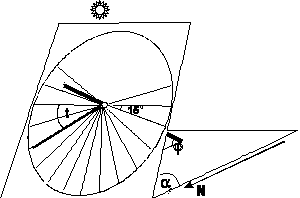


|
|
|
It is not known what civilization or when the sundial was invented, sundials can be found in many ancient civilizations, some of which are the Babylonians, Greeks, Egyptians, and Romans. The oldest known reference to sundials can be found in the Bible in Job 7:2. Sundials measure the apparent solar time, which is based on the idea that when the sun reaches its highest point in the shy it is noon, usually by measuring the position of the shadow of the sun as it changes throughout the day. There’re many different types of stationary sundials, one of which is the Equatorial Sundial. An equatorial sundial is the simplest sundial, comprising of a disk mounted on a bar, which is parallel to the Earth’s axis of rotation. The nest type of sundial is the standard garden sundial, a garden sundial uses the same principle as an equatorial sundial, but its lines are projected, using trigonometry, onto a face that is parallel to the ground. The advantage of the garden sundial is that it keeps time all year round and its face is never completely shaded in the daytime. The last type of stationary sundial is the vertical sundial, which were a traditional ancient convenience. Vertical sundials were large, inexpensive, and easily seen from large distances; they were commonly painted on walls. The main problem with vertical sundials is that they can only keep time for the half of the year in which the wall they are painted on faces the sun. Besides stationary sundials, there are portable sundials. On of the design for portable sundials is the Diptych sundial. Diptych sundials consisted of two flat faces joined by a hinge using a string as a gnomon between the two faces. The best materials used for this type of sundial were white ivory, inlaid with black lacquer markings and a black braided string. Diptyches were used to show the local apparent solar time. An even smaller design than the diptych was the elevation sundial. It was a small ring with a handle the when held a hole would cast a shadow onto the inside of the ring, telling the time by markings on the inside. Usually the hole was mounted on a sliding lockable piece of metal, which had to be adjusted to the correct date. The U.S Special Forces has begun to engrave a simple sundial onto their knife-blades so that they can have a watch, which never fails. |